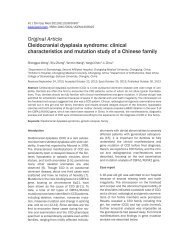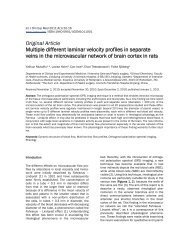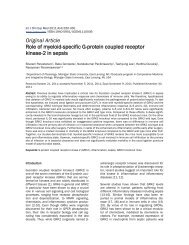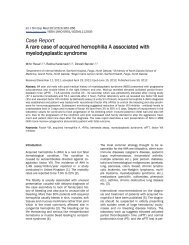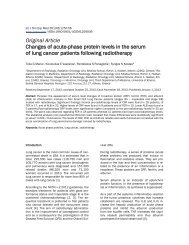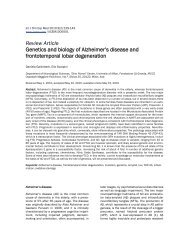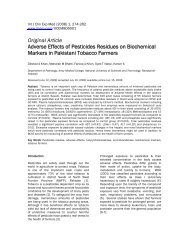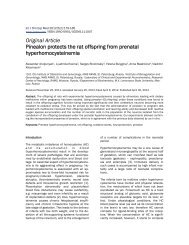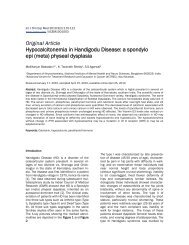Deciphering the MSG controversy
Deciphering the MSG controversy
Deciphering the MSG controversy
Create successful ePaper yourself
Turn your PDF publications into a flip-book with our unique Google optimized e-Paper software.
<strong>MSG</strong> toxicity in neurons activation<br />
<strong>MSG</strong>. We selected 3 µM <strong>MSG</strong> since it did not<br />
produce much injury. Neurons were first<br />
treated with 3 µM <strong>MSG</strong> for 12h, followed by<br />
treatment with 30 µM <strong>MSG</strong> for 24h. As shown<br />
in Figure 7A and C, pre-treating neurons with 3<br />
µM <strong>MSG</strong> for 12h reduced <strong>the</strong> subsequent<br />
neuronal injury by 30 µM <strong>MSG</strong> (n=3<br />
experiments). This data suggests that taking<br />
a low and non-damaging dose of <strong>MSG</strong> may<br />
prevent injury of neurons by subsequent high<br />
doses of <strong>MSG</strong>.<br />
Discussion<br />
Figure 7. Treatment with Vitamin C or<br />
pretreatment with low dose of <strong>MSG</strong> reduced<br />
<strong>MSG</strong> damage of mature neurons. A. Neurons<br />
treated with 30 µM <strong>MSG</strong> alone for 24h. B.<br />
Neurons treated with 30 µM <strong>MSG</strong> + 1 mM<br />
Vitamin C for 24h. C. Neurons were treated<br />
with 3 µM <strong>MSG</strong> for 12h followed by 30 µM <strong>MSG</strong><br />
for 24h. Scale bar: 20 µm.<br />
caused by subsequent long ischemic episodes,<br />
a phenomenon known as ischemic<br />
preconditioning or ischemic tolerance [13].<br />
For this reason, we determined whe<strong>the</strong>r a<br />
pretreatment of mature neurons with a low<br />
dose of <strong>MSG</strong> can establish tolerance against<br />
injury of neurons by subsequent high doses of<br />
Since <strong>the</strong> report of “Chinese Restaurant<br />
Syndrome” in 1968, various studies have<br />
confirmed <strong>the</strong> link between <strong>MSG</strong> intake and its<br />
side effects including headaches [4, 5]. In<br />
those studies, an oral dose of <strong>MSG</strong> at 3g or<br />
higher reproduced restaurant syndrome within<br />
30 min [5]. A direct intravenous dose of 50<br />
mg also produced similar symptoms.<br />
Although <strong>the</strong> <strong>MSG</strong> concentration in <strong>the</strong> blood<br />
is difficult to predict with oral doses of <strong>MSG</strong>, a<br />
direct intravenous injection of 50 mg <strong>MSG</strong> is<br />
expected to yield a blood concentration of 53<br />
µM (based on <strong>the</strong> total blood volume of 5<br />
litters). Although <strong>the</strong> blood brain barrier (BBB)<br />
has low permeability to <strong>MSG</strong>, <strong>the</strong> presence of<br />
high affinity glutamate transporters located at<br />
<strong>the</strong> BBB capillary luminal membrane could<br />
facilitate <strong>the</strong> uptake of <strong>MSG</strong> into <strong>the</strong> brain.<br />
Assuming 10% of <strong>the</strong> blood concentration can<br />
be reached in <strong>the</strong> cerebral spinal fluid, it would<br />
yield ~5 µM <strong>MSG</strong> in <strong>the</strong> brain which is above<br />
<strong>the</strong> threshold concentration of <strong>MSG</strong> for<br />
causing neuronal injury in our studies. Thus,<br />
<strong>the</strong> concentrations of <strong>MSG</strong> used in our studies<br />
were clinically relevant. Our finding that<br />
neuronal swelling takes place at ~30 min after<br />
<strong>MSG</strong> treatment is also consistent with <strong>the</strong> time<br />
course of <strong>MSG</strong>-induced headache in clinical<br />
studies.<br />
Using neuronal culture technique and cell<br />
injury assay, we studied <strong>the</strong> effect of <strong>MSG</strong> on<br />
mouse cortical neurons, a commonly used in<br />
vitro preparation for cell injury studies. We<br />
demonstrated that incubation with <strong>MSG</strong>, at<br />
clinical relevant concentrations, induced<br />
swelling and injury of mature neurons. This<br />
finding may partially explain <strong>the</strong> headache<br />
induced by <strong>MSG</strong> intake.<br />
In contrast to mature neurons, immature<br />
neurons are very resistant to <strong>MSG</strong> damage.<br />
For example, incubation of immature neurons<br />
334<br />
Int J Clin Exp Med (2009) 2, 329-336



